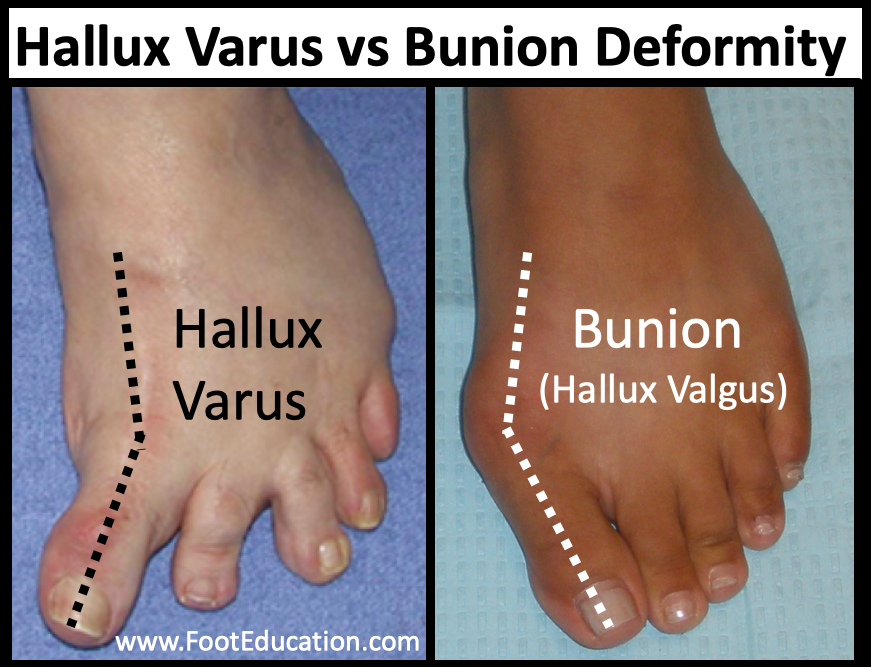Hallux Varus
Summary
Hallux varus is characterized by a deformity of the great toe where the toe is angled inwards instead of its normal position of pointing away from the midline (Figure 1). Many hallux varus deformities are mild and do not create any symptoms unless constrictive shoe wear is worn. The majority of symptomatic hallux varus deformities result from a surgical overcorrection of a bunion deformity. It is a known complication of bunion surgery, although it has become less common in recent years as surgical techniques have improved.
Symptoms
A hallux varus deformity can produce a variety of symptoms. Pain can result from the inward oriented great toe rubbing up against a shoe. Arthritic type pain can originate from the primary joint of the great toe (1st MTP joint) due to the change in orientation of this joint. There may be a notable limitation in shoe options with most shoes causing irritation and pain in the great toe. Additionally, many patients are frustrated at the cosmetic deformity associated with the great toe.

Physical Examination Associated with a Hallux Varus Deformity
A hallux varus deformity will be readily apparent by looking at the foot (Figure 1). The affected great toe will be angulated towards the midline (a varus deformity). If previous bunion surgery was the cause of this deformity a healed incision will be observed. Pressing on various points around the toe, including the first MTP joint may create discomfort. Movement of the great toe joint should be assessed. It is important to determine whether the hallux varus deformity can be fully reduced – can the great toe be reposition back to a normal position. It is also important to determine if the great toe joint moves smoothly without pain, or is the great toe motion limited and painful. Normally a great toe with hallux varus will have normal sensation and an adequate blood supply. Although the treating physician will want to assess both of these elements.
Imaging Studies
Plain x-rays of the foot taken from the front and the side with the patient bearing full weight are very helpful in assessing the cause and extent of hallux varus. The angle between the great toe and the first metatarsal will determine the extent of the hallux varus deformity. Additionally, evidence of previous bunion surgery, which often involves repositioning the first metatarsal bone, can usually be identified on plain x-rays.
Treatment of Hallux Varus
Non-Operative Treatment of a Hallux Varus Deformity
Many hallux varus deformities do not create any symptoms or have only minimal associated discomfort. These deformities can be treated easily with comfort shoes. Comfort shoes with a wide toebox and soft uppers will usually ensure that symptoms around the great toe or minimal. For more pronounced deformities with greater symptoms effective non-operative treatment may require some shoe modification. Shoe modifications that are helpful in the treatment of hallux varus include creating extra space to accommodate the inward deformity of the affected great toe. If arthritic changes of the great toe joint leads to pain then activity modification, anti-inflammatory medication, and even a corticosteroid injection may be beneficial.
Surgical Treatment of a Hallux Varus Deformity
Many hallux varus deformities, particularly those that result from previous bunion surgery, require surgery to correct. A pronounced and symptomatic hallux varus deformity can be a surgical challenge. The most predictable surgical correction for a notable hallux varus deformity is a great fusion. This will predictably correct the great toe deformity and alleviate any pain that is originating from the primary great toe joint (1st MTP joint). However, a great toe fusion procedure causes loss of all motion from the first MTP joint, which is frustrating for many patients. A variety of surgical procedures have been tried in an effort to correct the hallux varus deformity and preserve the first MTP joint motion. The procedures include:
- Revising the previous bunion surgery often by re-cutting and repositioning the first metatarsal bone
- Reconstructing the ligaments around the first MTP joint
- Transferring some or all of the main tendon that lifts up the great toe (extensor hallucis longus) to maintain the position of the great toe
All of these surgeries are associated with the potential complications typically seen with orthopedic surgery including: infection, wound, healing issues, nerve, injuries, DVT, and persistence of symptoms. The non-fusion options for treating hallux varus do you have a fairly high risk of recurrence of the hallux varus deformity. The hallux varus deformity if severe and symptomatic is often a frustrating problem for patients, particularly when it stems from an overcorrection of a bunion deformity.
June 17th, 2024